How to Build Real Time Apps with Node.JS
Krunal Panchal
July 28, 2022 778 Views
Quick Summary : This article is about how to build real time apps development. It explains how real time apps are used in web applications and how it works.
Today, most developers create apps that users can interact with in real time apps, as time’s value is rising steadily in our digital age. Real-time features are integrated into all types of apps, including web, desktop, and mobile. Apps typically offer real-time services such as texting and alerts.
Nowadays, most online applications run within milliseconds. However, some corporate jobs have much stricter requirements. In addition, a moderately fast speed is no longer sufficient.
In the modern financial world, robots compete against one another, and frequently the victor is the one who is able to edge out the rival by a fraction of a second—the extra microseconds can cost millions. It is common in telecommunications to require processing time guarantees for each item, regardless of the system’s overall load.
Flash-like predictability becomes essential to providing fair conditions for all players, even in heavily loaded online games.
When considering the end-user, we used to live reactively, and a slight delay might sabotage the occasion. Real-time web apps have extended to other industries after dominating the stock market trading business. People have gotten used to using live chats, stories, and video conversations and adoring such exquisite typing indicators that it has become second nature. It approaches.
How Do Real Time Apps Work?
Software applications (web or mobile) that operate within a current or immediate time frame are known as real-time applications (RTAs for short).
The consumer has a real-time experience because the time frame is measured in seconds. Real-time apps include those that enable video streaming, web conferencing, live chatting/messaging, and notifications.
Why Choose Node.js for Developing Real Time Apps?
To understand Node.js’ significance, we need to define it first. It is an open-source JavaScript runtime environment. Moreover, before the page is delivered to the user’s web browser, developers are able to create dynamic content using JavaScript by writing scripts for command-line tools.
As a result, Node.js’ event-driven features and non-blocking I/O support applications that aim for speed, extremely high performance, and scalability. Node.js provides all the tools necessary to create speedy, easy, versatile applications and more.
Node.js primary benefit, which places it at the top of the list for real-time programmes, is that it is asynchronous and event-driven. Building web apps with node.js is an excellent option because of its capacity to manage the most number of real-time users at once and execute multiple requests all at once.
Benefits of Building Real Time Apps with Node.JS
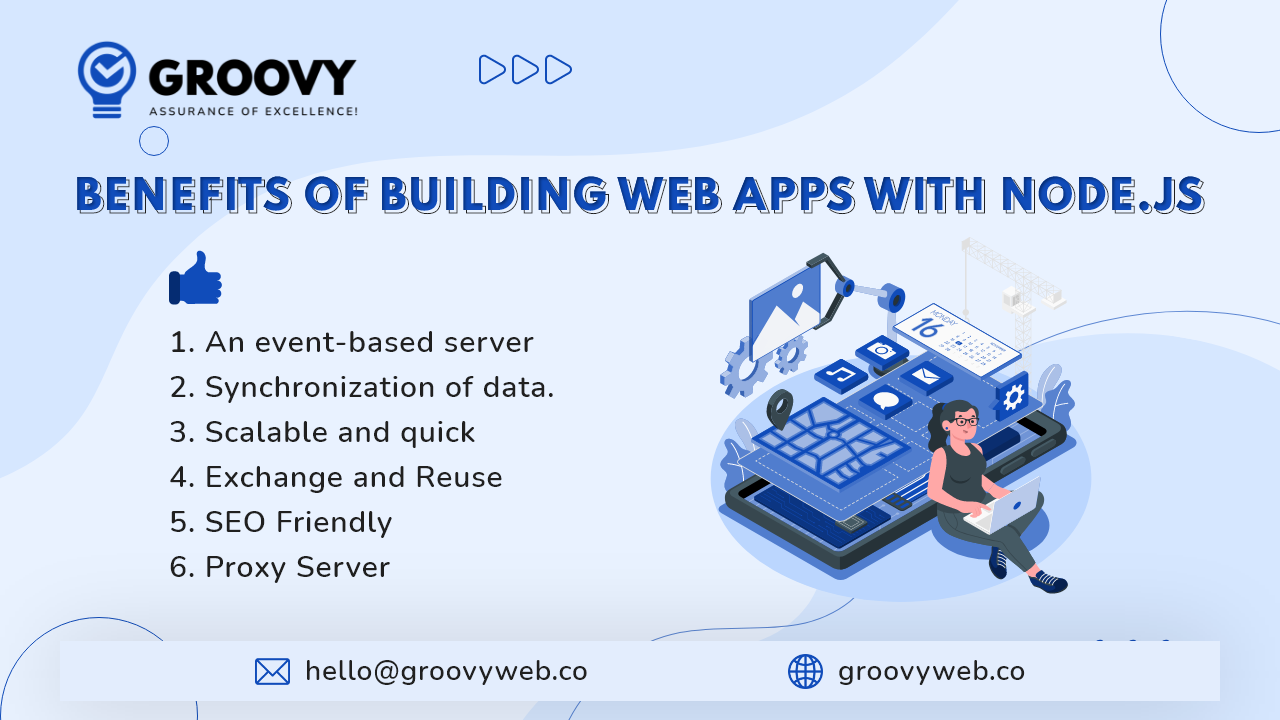
Here are the 6 benefits of using Node.js while creating real time web apps:
1. An event-based server
Numerous real-time consumers are dealt with via real-time programmes. Development with Node.js supports response-based on the event-driven server that helps non-blocking operations.
2. Synchronization of data.
A Node.js developer uses the non-blocking I/O feature appropriately. A lot of data is transferred between a server and a client.
3. Scalable and quick
As a JavaScript-based programme, Node pulls the application more quickly than JS. As a result, a programme using an event loop and a single-threaded model can easily handle multiple client requests.
4. Exchange and Reuse
Node. js helps microservice architectures by supporting real-time programming. It enables programmers to reuse the library code bundle and distribute it across other projects. Additionally, it aids developers in fostering increased productivity and time savings during real-time web application development.
5. SEO Friendly
SEO is essential for existing in the online world. You should include Node in the app development tech stack if you don’t want to lose out on SEO. The backend rendering of Node.js improves interaction and raises the site’s visibility.
Besides delivering a great user experience and fast loading speeds, these applications also have top-notch performance, which is crucial for ranking high in Google’s search results.
6. Proxy Server
In cases when intermediary admins are required, Node is also the best choice. A developer needs to add 20 lines of code to a Node.js server to use it as a proxy server. Then their programme is ready to help with streaming data from various sources.
Disadvantages of Building a Real Time App with Node.JS
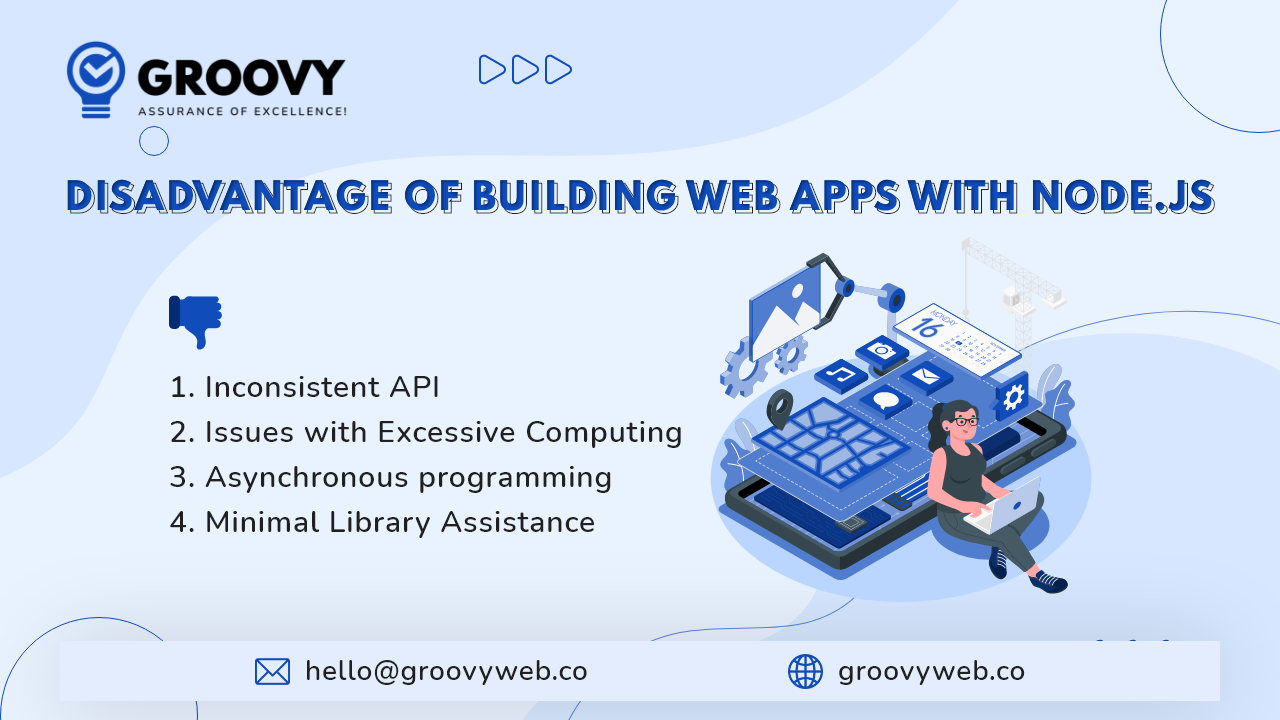
Inconsistent API
One of the main strengths of the Node.js architecture gives rise to the main problem with Node.js. Numerous developers have discussed the issues brought on by the Node.js API’s constant modifications.
Backwards-incompatible modifications can also be introduced by often introducing new API changes. Therefore, updating accessible code bases could require engineers to lose their precious time. Developer productivity may be impacted by the worry about maintaining compliance with the most recent Node.js API versions.
Issues with Excessive Computing
Developers must also be aware of Node.js drawbacks, such as issues handling demanding processing workloads. The event loop as a whole is slowed down by Node.js’ allocation of all available CPU power to event loop activities.
Asynchronous programming
In Node.js, callbacks play a vital role in asynchronous programming. The callback function occurs after each task in the queue, ensuring that other background processes are not adversely affected. Callbacks occasionally have a direct impact on the efficacy and speed of code.
As a result, Node.js users could run into some constraints while trying to maintain their code, especially if they have a lot to do and are under time pressure.
Minimal Library Assistance
The absence of library support is the next significant drawback of Node.js for developing applications. Numerous inferior or unfinished NPM registries and libraries are available that lack adequate documentation.
As a result, novices are more likely to run into issues while trying to monitor corrupt libraries and registries.
Among the significant drawbacks of open-source libraries is their lack of focus on code standards. Because of this, Node.js developers face difficulties implementing necessary programming tasks.
Node JS Architecture for Real Time Applications
One of the most common justifications for scaling programmes is the workload, and this is where Node.js is useful. It offers scalability to increase availability and support for real-time app failures. As a result of its event-driven and parallel nature, Node.js has consequently emerged as one of the greatest programming languages for creating real-time applications.
Since Node.js uses a single thread event loop architecture, It runs differently from other runtimes. We will walk you through the steps of how Node.js functions.
- First and foremost, Node.js concentrates on keeping a small thread pool for handling requests.
- When a new request arrives, Node.js adds it to a queue, at which point the single-threaded “Event Loop” module begins to operate. The event loop‘s main task entails endlessly waiting for queries.
- A backlog of incoming requests is collected, and the loop is checked to see if there are any blocked I/O needs. When no blocking I/O operation is required, the loop processes the request and sends the response.
- An internal thread will be selected to handle queries if a blocked activity occurs. Restricted worker subgroup inner threads, often known as an event loop, are accessible through the event loop.
- After completing the blocking operation, the loop checks the delayed responses and adds them to the list. This allows the cycle to maintain its non-blocking nature throughout its performance.
In website development, Node.js’s use of fewer threads promotes operational efficiency. As well as speedier task completion, one can also benefit from it. The single-threaded structure, therefore, offers potential assistance for creating real-time web apps.
A single-threaded event loop architecture in Node.js allows for handling multiple interconnected clients in real-time. In contrast, multithreaded request-response architecture is used by technologies like ASP.NET, HTML, AJAX, and JQuery to manage several concurrent clients.
However, the architecture of Node.js sets it apart from other technologies. The following benefits are associated with the single-threaded event loop architecture:
- It is easier and easier to handle simultaneous client requests.
- Node JS based apps use fewer threads since they need less memory or processing power.
- Due to the event loop, a NodeJS-based programme receives more concurrent client requests without the need to add more threads.
- Its architecture allows for multi-threading and parallel processing.
This architecture was adopted primarily because a single main thread is more scalable and performs better under ordinary web loads than more traditional “one thread per request” architectures. Therefore, Node.js is popular among real-time systems due to its scalability and speed.
Node.js Suitability For Developing Real Time Apps
The appropriate framework can be either Express.JS or Feather.JS. You may discover effective Socket.IO integration in Feather.JS. It takes the Socket.IO library and Express.JS framework to create a simple chat application in Node.js.
Socket.IO
It functions just like the best JavaScript library when used with real-time web projects. It helps developers by establishing real-time, bi-directional communication between the server and web clients. The browser has a client-side library, while Node.js has a server-side library.
The same API is present in both elements. It is event-driven, just like Node.js. The Socket.IO provides a way to conduct real-time analytics, real-time communication, streaming of binary data, and collaborative document writing.
Real-time Applications Utilizing Socket.io Using Node.js
Chat Applications
We can think of many examples in this regard, including messaging apps like WhatsApp, Instagram, Facebook Messenger, and many others. Here, you may share pictures and videos while texting or chatting in real-time. The Socket is what makes this all happen so swiftly. iO.
The Socket.iO module initially gets the data from your end, notifies the user (the person you are texting or transferring files to) and proceeds according to the identical steps from the user’s end. It happened rapidly and gave the impression that we were in-the-moment conversing.
App For Video Conferences
Apps for video conferencing are frequently created using the iO platform. However, the architecture at this place differs slightly.
The Socklet.iO sends videos to the servers in brief streaming rather than directly operating. The server collects the bits and creates a complete video and poem for the viewers when it receives the final pieces of the video.
Video buffering may have happened to you in the past when using a bad internet connection. The steps mentioned earlier are what cause the video to buffer.
Multiple-Player Gaming Programs
The Socket.iO library effectively manages the high data load and rapid data sharing between client and server sides that occur in multiplayer gaming applications.
The Socket.iO methods are designed to accept data from several different calls concurrently. However, it restricts sharing to pertinent gamer profiles, giving users a hassle-free gaming experience.
Express.JS
It functions like a Node.js framework and makes use of numerous useful features to arrange the app’s routing. Any templating solution can be dealt with easily by it. It improves the fundamental functioning of Node.js, and Additionally, it enables better code structure.
Why is Express.js required for Building Realtime Apps with Node.js?
- Many programmers are under pressure to create effective real-time apps quickly. However, developing and testing web applications takes time, and at this point, Express.js saves the day for programmers.
- Using Express.js allows us to develop web-based applications more quickly and reduce coding by half. Its various capabilities allow web apps to be created faster and easier.
- Another advantage of Express.js is that it supports JavaScript. Express.js supports JavaScript, which makes it easy for beginners to begin web application development careers.
- Anyone can study Javascript fairly easily, even without previous programming experience. Consequently, Express.js enables new web app developers to succeed.
- Thanks to the event-driven nature of Node.js, it can handle tens of thousands of client requests simultaneously, something PHP cannot do.
- Our society is increasingly dependent on real-time online applications and services. In order to support real web apps, Node.js must be used, and web applications with real-time chat are the most common.
Real-life Examples Of Real Time App Development Using Node.js
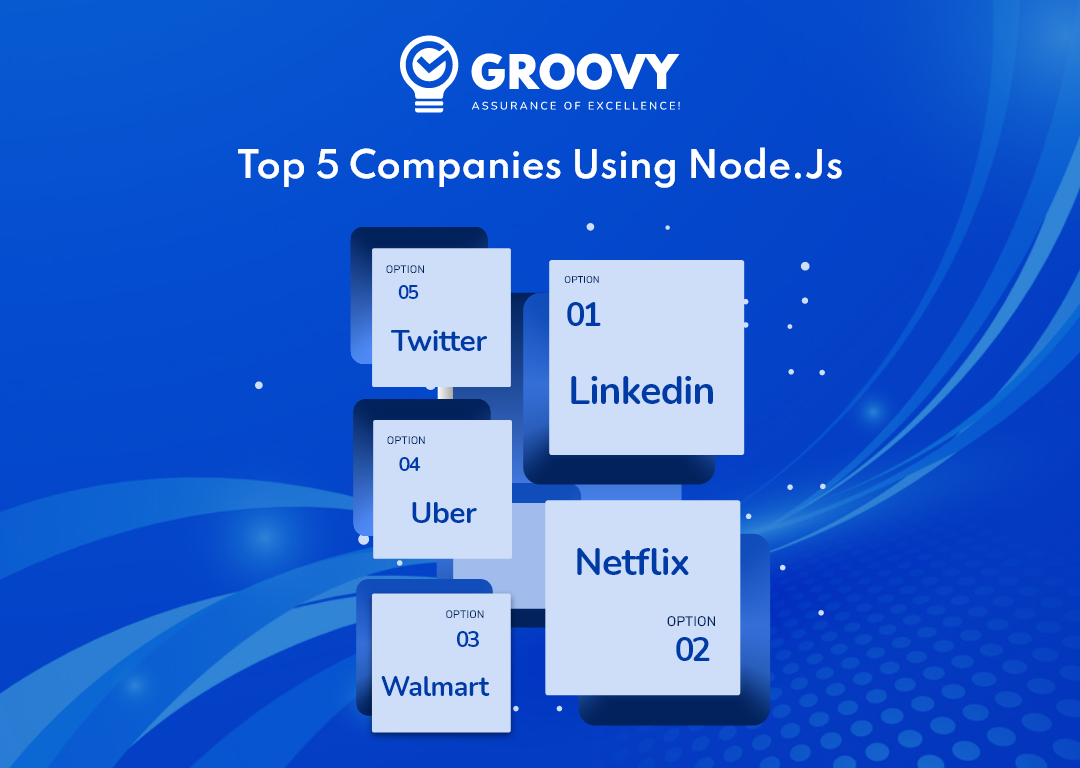
There are numerous real-time node.js application examples. It has been the foundation for several well-known and reputable businesses, including Paypal, Netflix, Airbnb, Uber, LinkedIn, and Walmart.
Twitter Lite
In order to reach every person on the earth, Twitter’s management came up with the concept of Twitter Lite. The popularity of Twitter Lite has greatly increased due to the use of Node.js in the backend. The Node.js capabilities have increased the app’s accessibility and allowed for the fastest performance in any browser. Despite a slow internet connection, users can access the app even when the app is offline, thanks to the service worker.
Netflix
The well-known OTT service Netflix was formerly a DVD store. Millions of people may now stream simultaneously on the platform, which has grown to be the biggest in the world. Node.js in the backend is what makes this platform so effective. The restful instances that Node.js has created are housed in different Docker containers. This improves performance and makes the application more scalable.
GoDaddy
GoDaddy serves a sizable user base and manages over 70 million registered domains. GoDaddy selected Node.js for the backend in order to handle the enormous quantity of traffic. A complete staff of full-stack JavaScript engineers works for GoDaddy. The adoption of the microservices architecture has changed the deployment time to less than one minute. Additionally, GoDaddy switched its website building platform to Node.js, which resulted in a 10x reduction in the number of servers.
Uber
Uber provides quick, on-demand taxi services, and its app is incredibly user-friendly. Due to living tracking and other Node.js characteristics, they are able to provide excellent and quick services. Node.js is the top choice for app development due to its ordered code, capacity for handling enormous volumes of data, and affordability. Uber maintains its core by using JavaScript on both the front and back end.
Common Features to Take into Account While Develop Real Time Applications
Real-time features and configurations are used in the development of several businesses and industry titans, including WhatsApp, Slack, Uber, Zomato, and Netflix. Their service continues to be enhanced with new features while maintaining seamless operation over time.
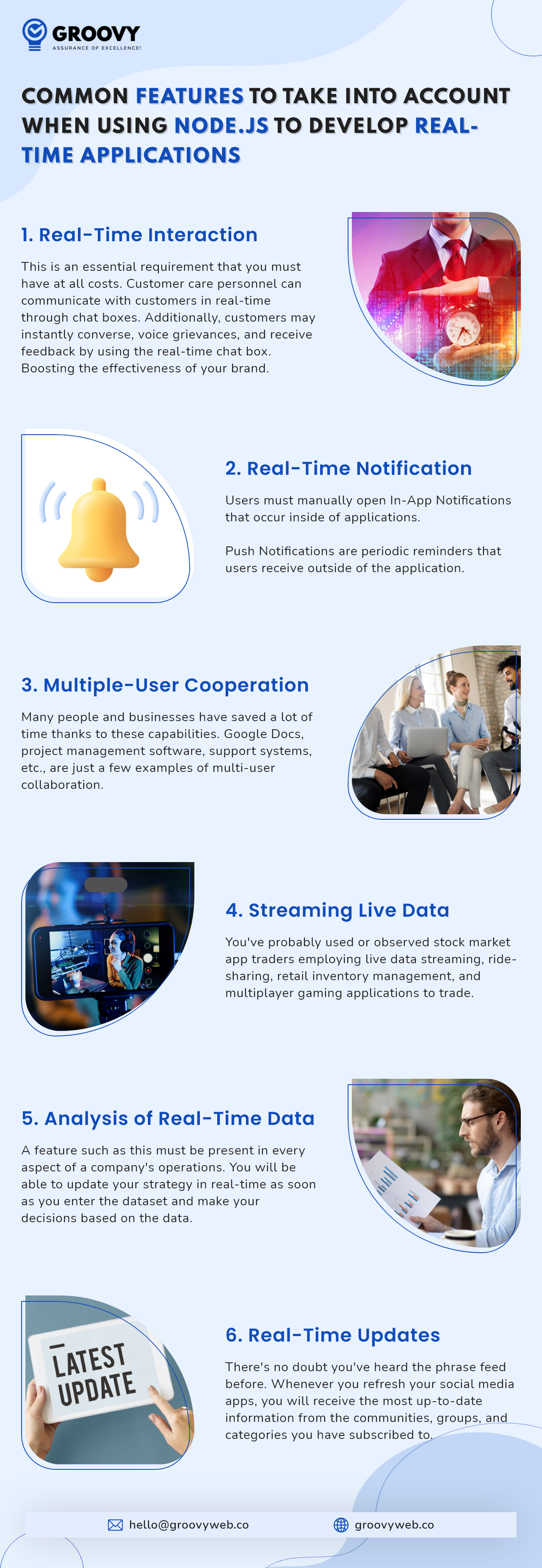
There are a few elements you need to consider if you wish to create real-time Node.js applications that have the same capabilities as the apps mentioned above.
Real-Time Interaction
This is an essential requirement that you must have at all costs. Customer care personnel can communicate with customers in real-time through chat boxes.
Additionally, customers may instantly converse, voice grievances, and receive feedback by using the real-time chat box. Boosting the effectiveness of your brand.
Real-Time Notification
Provide people with the most recent information about your brand and its operations by letting them know how you are adding new products, videos, and audio. You have a choice;
- Users must manually open In-App Notifications that occur inside of applications.
- Push Notifications are periodic reminders that users receive outside of the application.
Both completed the same task and improved your brand.
Multiple-User Cooperation
Many people and businesses have saved a lot of time thanks to these capabilities. Google Docs, project management software, support systems, etc., are just a few examples of multi-user collaboration.
Here, functionality is straightforward. The real-time data quickly sends changes to user requests to another user, and the User reacts appropriately. All really promptly and plainly!
Streaming Live Data
You’ve probably used or observed stock market app traders employing live data streaming, ride-sharing, retail inventory management, and multiplayer gaming applications to trade.
These apps provide live data streaming features that provide users with real-time updates on their activity.
Analysis of Real-Time Data
A feature such as this must be present in every aspect of a company’s operations. You will be able to update your strategy in real-time as soon as you enter the dataset and make your decisions based on the data.
Real-Time Updates
Aren’t you all on social media? There’s no doubt you’ve heard the phrase feed before. Whenever you refresh your social media apps, you will receive the most up-to-date information from the communities, groups, and categories you have subscribed to.
Also, customers and restaurant/hotel owners have no longer had a disconnect because of the live food order status.
It’s a fantastic addition that fosters confidence and provides honest ratings and feedback that will help your business grow appropriately.
Cost of Developing a Real Time Apps
Calculating the total cost of creating real-time apps like messaging applications is one of the most complicated tasks for developers.

Nevertheless, depending on the features and options you choose for your app, you can expect to pay between $75,000 and $400,000 plus additional costs.
The following method will help you estimate how much it will cost to create an app that is similar to WhatsApp and Telegram:
Final development costs are calculated as follows: Total development hours worked multiplied by the developer’s hourly rate.

It is important to remember that time and price are only estimations and can vary according to the project’s complexity and requirements.
Conclusion
That’s all, then! You are now prepared to use Node.js to develop your real-time application and connect everything with great performance and scalability.
Knowing the benefits of Node.js for creating real-time apps has certainly piqued your interest in starting a new project based on this technology. It’s time to take the initiative and quickly turn your ideas into reality, whether you need to engage a professional Node.js development business or build a node.js app.
As a well-known Node.js development company, Groovy Web offers both businesses and individuals highly scalable solutions. To complete your next project, you can employ Node.js developers.
Written by: Krunal Panchal
Krunal Panchal is the CEO & Co-founder of Groovy Web. Krunal has been a hardcore programmer since he was 11 and started his professional career very young. His technical and logical mind drove him to choose coding as his destiny. At an initial stage, he got essential experience and the spirit of innovation and entrepreneurship. Learning something new is a never-ending process for him. Under his leadership, Groovy Web has become an established organization that serves industries from startups to enterprises, regardless of any limitations.
Frequently Asked Questions
We hope these clear your doubts, but if you still have any questions, then feel free to write us on hello@groovyweb.coWho is using Node.js?
Here’s a brief list of major companies that have put their trust in Node:
Twitter
Reddit
eBay
Uber
Netflix
Medium.
How fast is Node?
Regarding PHP, Ruby, Java, or Python, apps built with Node.js will exhibit more outstanding performance. The event-driven architecture of Node.js makes it a fast technology—instead of creating multiple threads for each request or waiting for one request to finish before starting another, Node.js initiates numerous simultaneous requests.
Related Blog

Rahul Motwani
UI Mistakes To Avoid When Developing An App In 2023
UI/UX Design 26 May 2023 12 min read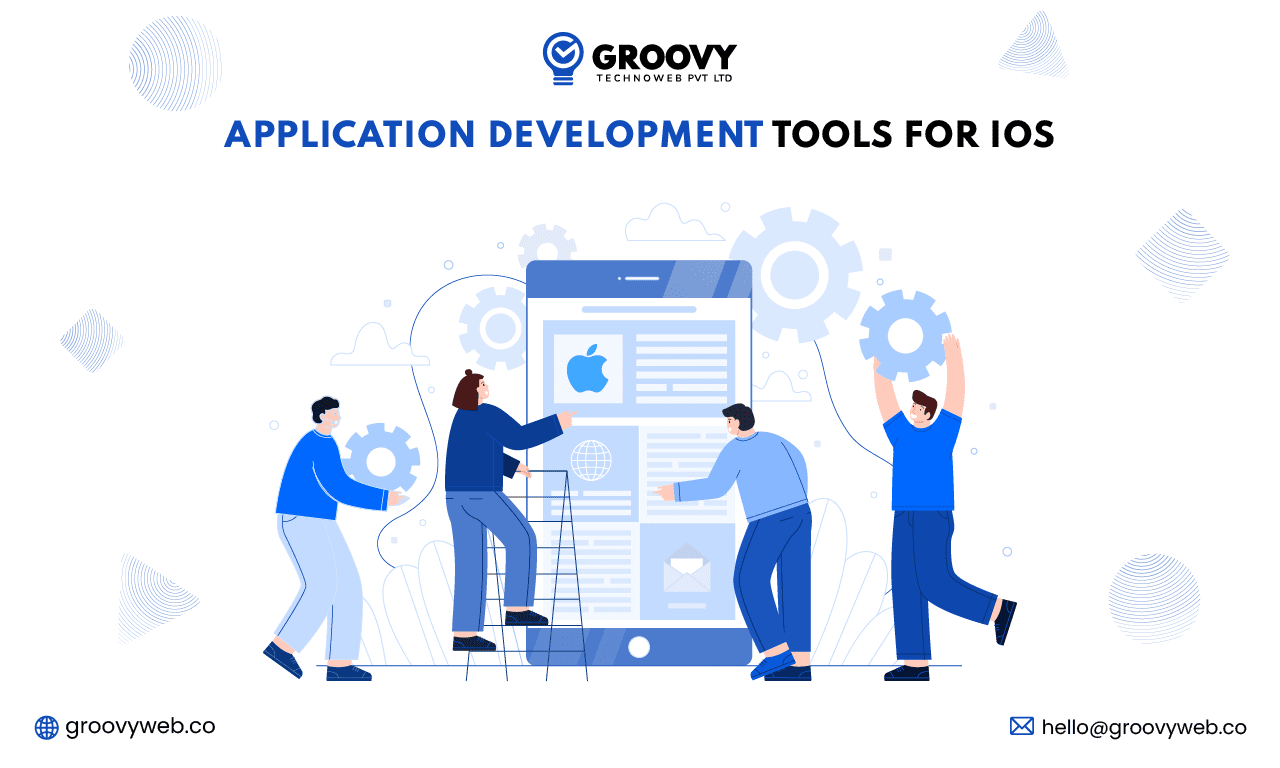
Rahul Motwani
Best iOS App Development Tools for Startups
Mobile App Development 08 Jun 2023 6 min readSign up for the free Newsletter
For exclusive strategies not found on the blog
